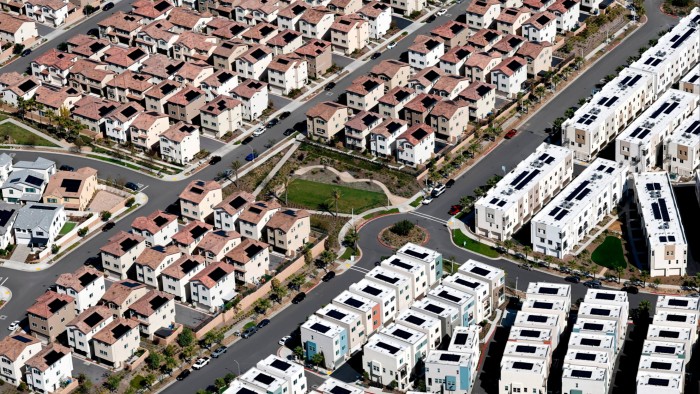Donald Trump’s new tariffs are set to pummel the renewable energy industry, threatening to push up prices, disrupt supply chains and undercut US ambitions to lead the artificial intelligence revolution, clean-technology executives said.
The duties of 10 per cent to 49 per cent on electrical components, battery storage and other equipment from China, south-east Asia and Europe pose a one-two punch for an industry already reeling from Trump’s embrace of the fossil fuel industry and limited appetite for clean energy.
Executives warned that the added costs from tariffs would in turn prompt higher power bills. Electricity prices rose twice as fast as inflation last year, according to Bank of America, with several utilities requesting double-digit price increases from regulators to cover the rising costs of labour, materials and upgrades to the grid.
“This could be a potential de-railer when we really have to usher in this new era of energy dominance to put the US at the epicentre of data centres and AI technology,” said Sandhya Ganapathy, chief executive of EDP Renewables North America, one of the largest developers of wind, solar and battery storage in the US.
“It is unsettling from a business perspective and creates disruption,” she added.
Julien Dumoulin-Smith, analyst at Jefferies, an investment bank, said the tariffs created “a lot of turmoil” at a time when businesses were already uncertain about whether Trump would axe lucrative incentives for green energy provided by former US president Joe Biden.
He said: “Tariffs provide another reason for companies to delay investments. And the current problem is that there just isn’t a big enough domestic US supply chain yet in many renewable sectors, such as solar, battery storage and wind. There aren’t many options but to purchase from overseas.”
Biden sparked a reshoring boom by offering hundreds of billions of dollars of tax credits in a radical shake-up of industrial policy through the Inflation Reduction Act and Chips and Science Act. More than 200 large-scale manufacturing projects have been launched since the legislation passed more than two and a half years ago, although many plants have not begun production.
Analysts say green energy is particularly vulnerable to tariffs given its heavy reliance on overseas imports and reduced government support. Trump has vowed to dismantle the IRA, calling it a “green new scam”, paused permitting and loans for some renewable projects and prioritised developing fossil fuel projects. This has chilled investment in the green energy industry, which faces the additional cost of sourcing equipment from countries subject to punitive tariffs.
One of the most exposed supply chains is battery storage, which is essential for storing renewable energy. Last year, more than 90 per cent of lithium-ion energy storage cells deployed in the US storage market originated from China, according to Rho Motion, a data research company. And despite efforts to build up domestic production in the US, there is not enough national capacity to meet demand.
Imports of Chinese storage cells face an extra 34 per cent rate, in addition to a previously announced 20 per cent by the Trump administration. Overall, existing tariffs on battery storage, the new Trump tariffs and previously planned tariff increases announced by the Biden administration will bring total duties on Chinese cells up to 82.4 per cent in 2026.
“The US storage industry will be paying considerably more for cells than elsewhere,” said Iola Hughes, analyst at Rho Motion.
Hughes said some US domestic manufacturing of storage cells was increasing but even these factories would remain reliant on imports of cathodes from China, which would still be subject to tariffs.
The US’s solar panel manufacturing industry has grown rapidly in recent years but the country nonetheless imported about 95mn photovoltaic panels last year, partly because of developers stockpiling ahead of anticipated changes, according to figures from Rystad Energy.
The bulk of the imports came from countries facing high tariffs, including Vietnam, Malaysia and Thailand. These follow extra duties on their solar imports announced last year, before Trump took office. Marius Mordal Bakke, vice-president of solar research at Rystad, expects the US to start importing more from the Middle East and Africa.
“We expect some acceleration in the ramp-up of domestic cell and module plans, but the costs for developers will still go up,” he said. The US also relied on polysilicon and wafer imports, he added.
The US wind sector imports a lot of components such as blades, drivetrains and electric systems, with almost half of imports coming from the EU in 2024, according to Rystad. A February report by Wood Mackenzie warned that universal 25 per cent tariffs on all imported wind products would increase project costs by 7 per cent and put some projects at risk.
The US also imports a lot of components that are critical for upgrading electric grids to ensure they can meet surging power demand. These will now become more expensive and drive up electricity prices for customers, say executives.
EDP’s Ganapathy said: “Whether it’s transformers [or] whether it’s circuit breakers, a lot of them are coming from overseas, Canada or Mexico or other parts of the world. And [the imposition of tariffs] not just impacts new projects that we want to put in the ground, it impacts the grid stability.”
“The fact is we have to keep pace with a very, very increasing energy demand scenario,” Ganapathy said.
Read the full article here

